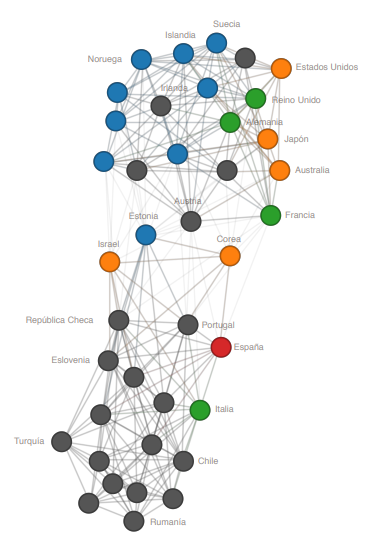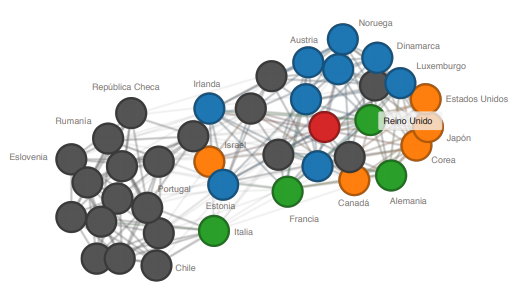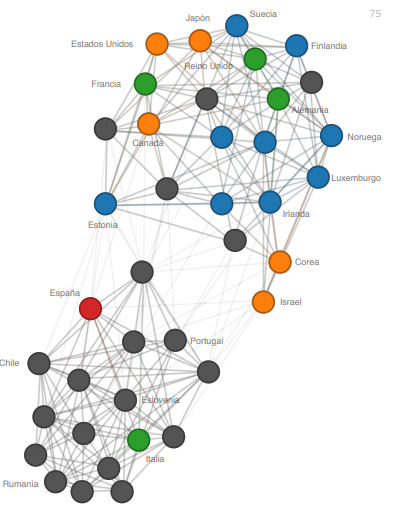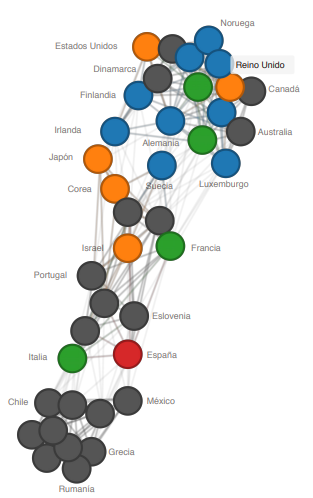Spain does not occupy an important place among the group of leading countries in terms of digitalization, neither globally nor in its European context, according to the Secretary of State for Digital Advancement and the president of the Spanish Association of the Digital Economy.

Global Diagnosis: Orange = Global Leader, Green = EU Big4, Red = Spain, Blue = EU Digital Leader
In an 80-page report by Adigital called “ESPAÑA NACIÓN DIGITAL: A vision of the state of digitalization in Spain,” Spain is lacking in both Europe and the world when it comes to digitalization, and this is affecting job opportunities and growth.
The report was presented by The Secretary of State for Digital Advancement, Francisco Polo, and the president of the Spanish Association of the Digital Economy (Adigital) Carina Szpilka.
Through the analysis of more than 80 key indicators, the report examines the leadership possibilities of Spain vis-à-vis other countries in the digital economy. It explores the main categories and the position of Spain in each of them, and here we highlight Adigital’s conclusions and recommendations for a digital Spain.
Global Diagnosis
Analyzing all the indicators as a whole (both in terms of context and digitalization), Spain clearly belongs to the group of second-tier economies, far from the group of digital leaders (except Estonia) and the main European countries (except Italy).
As a first step, it is necessary to make an extra effort to reach the leading group, and, secondly, to be above the rest of the major European countries.
Infrastructures and Use

Considering the variables of Infrastructure and Use, two clusters of countries are clearly distinguished.
Spain is in the group of the most advanced economies, with greater similarities with the major European economies (except Italy) and with notable differences with the small European digital leaders.
Main areas of work:
The indicators most used in the field penalize Spain by not taking into account ultra-fast BA networks (e.g. FTTH), being necessary to build the right narrative and insist more in that regard. Other areas of work include:
- More investments in the deployment of high speed / capacity networks, fixed and mobile, supporting the reduction of associated costs and reduction of tax burdens.
- Spectrum management policies suitable for the promotion of investment.
- Coherent development of sector regulation.
- Improved communication about the importance and advantages of the digital society among the general population.
- Promotion of the adoption of technological solutions in companies, particularly in those of a smaller size.
- Greater development and use of digital public services.
Environment and Market

Considering the variables of Environment and Market, two clusters of countries are clearly distinguished: Spain is in the tail of the intermediate cluster, with better metrics than Italy, but far from the rest of the large countries of the region and European digital leaders.
Main areas of work:
Full development of the European Single Market, defragmentation of the Spanish internal market and elimination of barriers (regulations, training) to export and access to third markets. Other areas of work include:
- Greater use of the Spanish language as a key to new markets.
- Establishing a broader, clear and stable framework of support for R & D & I, with greater private involvement, which helps raise investment levels.
- Developing centers of innovation and excellence, with a greater degree of regional and sectoral specialization.
- Improved access to finance and venture capital for innovative projects and companies.
- Promotion of innovative public procurement and improvement of technology transfer mechanisms.
Capacities and Talent

Considering the variables of Capacities and Talent, three clusters of countries are clearly distinguished: Spain is with Denmark in the intermediate cluster, with magnitudes similar to those of France and Italy, but well differentiated from the characteristics presented by European digital leaders.
Main areas of work:
- Promoting digital literacy at all levels and ongoing training.
- Improving the quality of the basic education system and its results in international comparisons.
- Reducing existing gaps (gender, etc.) in terms of digitization at the population level.
- Strengthening education in science, technology, engineering and mathematics (STEM).
- Reducingthe gap between training of ICT specialists and employment of them in the economy.
- Greater efforts to attract international talent, and visibility of existing ones.
- Increasing technology and digital adoption by small businesses.
There is a strong correlation between the degree of development of a country (for example, measured by its GDP per capita) and its level of digitalization, but even in the most advanced economies, the process of digitizing Spain’s economy is in its early stages.
Its impact on productivity and efficiency can be a fundamental factor in mitigating the negative impact of population aging in advanced economies, being a critical enabler for the development of knowledge-based societies and for transformation into information societies.







